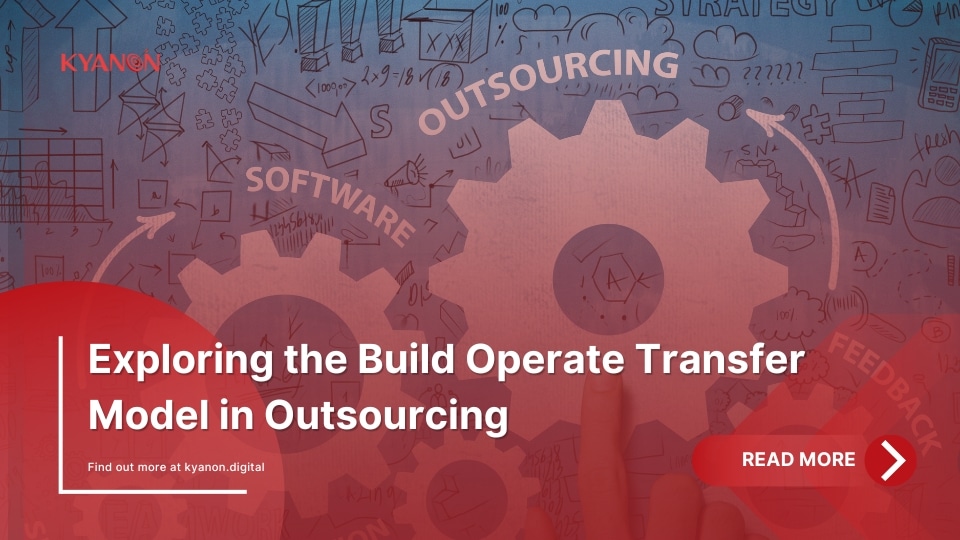In the modern world, IT software outsourcing is a strategy that has gained popularity because the advantages it offers have brought improvements to business performance; however, there is an unavoidable presence of concerns regarding the loss of ownership, operational control, or any possible damage.
As a result, a build operate transfer model – B.O.T team is considered an efficient option to decrease the uncertainties to a minimum among a variety of IT outsourcing engagement models. In this article, Kyanon Digital will inform you of everything you need to know about B.O.T and the benefits this model presents to your business.
1. What is the Build Operate Transfer (B.O.T) Model?
According to Gartner, a B.O.T. team is defined as a contractual relationship in which an enterprise engages a service provider to build, optimize, and operate an IT or business process service delivery operation with the contractual intent to transfer the operation to the enterprise as an in-house operation.
As a hybrid model, build operate transfer (B.O.T) includes aspects of both the “build” option (also known as “insourcing” or a captive center) and the “buy” option (commonly known as outsourcing; see also “captive centers”).
In software outsourcing, the B.O.T model is a strategy in which a software house establishes, enhances, and manages a fully operational software development center to a desirable degree of maturity. At this point, the customer receives a complete transfer of ownership.
Seeking a B.O.T. team is an easy and effective method of software outsourcing, as they will be responsible for the functioning and operation of the solution. If there are any errors, the vendor will be the one who fixes it. Therefore, this strategy allows clients to minimize risks and prevents them from experiencing technical difficulties.
At the final stage, they will gain a solution that is ready to function stably. Thus, this makes the model suitable for large intergovernmental deals as well as smaller partners.

2. How does The Build Operate Transfer (B.O.T) Model Work?
The B.O.T model in software outsourcing is based on the following main phases: Build, Operate, and Transfer. These phases are conducted during the development and growth of the unit and in preparation for the transfer to the company.
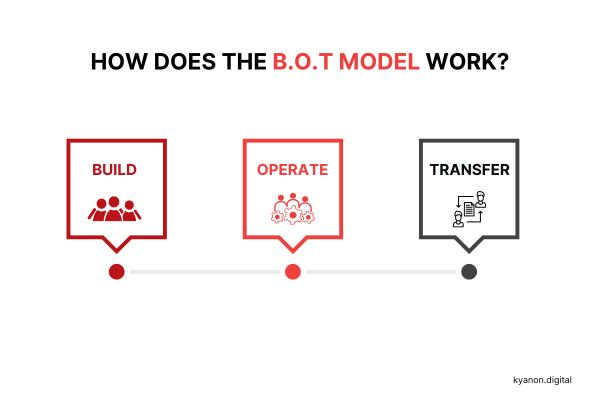
2.1 Build
The build operate transfer model begins with the Build phase, where the outsourcing partner conducts comprehensive market research and evaluates the client’s goals, capabilities, and project needs. This stage requires in-depth planning and close collaboration between both parties to ensure alignment.
In the Build phase of the build operate transfer model, the service provider establishes a robust legal framework for the project, ensuring compliance with regulations. They also handle the provision of essential hardware, technology infrastructure, and a productive working environment for the team.
This phase lays the foundation for the seamless transition into the Operate and Transfer phases of the build operate transfer model.

2.2 Operate
The Operate phase of the build operate transfer model focuses on the day-to-day management and execution of the project. During this stage, the B.O.T. team oversees everything, from product development and maintenance to providing technical support. This ensures that all processes run smoothly and meet the desired quality standards.
A key aspect of the Operate phase in the B.O.T model is implementing growth strategies and scaling the project according to the predefined plan. The team also prioritizes team coaching and personal development to achieve optimal business maturity and technical capability.
Typically, this stage lasts for a fixed period, ensuring the foundation is strong for the eventual transfer phase.

2.3 Transfer
This is the final stage of build operate transfer model. At this point, the client receives ownership rights from the third-party vendor. It happens when the client company declares that they are capable of handling the project independently. Simply put, the transfer phase begins when the client organization is mature enough to undertake project responsibility.

3. The Advantages of the B.O.T Model
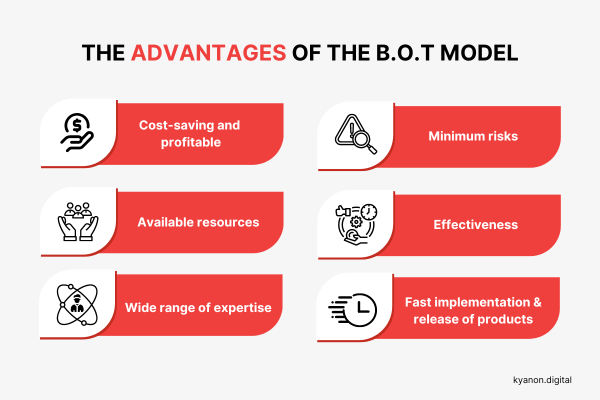
3.1 Cost-saving and profitable
B.O.T., like other outsourcing strategies, aims to reduce costs whenever practicable. By transferring the work involved in IT operation setup and maintenance to a third-party vendor, you can avoid the trouble of setting up an internal IT staff or investing in significant resources. This aspect alone has already made an outstanding contribution to saving a considerable amount of money that would otherwise be an investment or for employing more talented resources. The outsourcing company’s effective operations enable its partners to reduce operational expenses while increasing profitability.
3.2 Available resources
One of the most significant advantages of using the B.O.T project delivery mechanism is that you will not be under pressure to seek resources, hire software developers, and give them the necessary software and hardware for project execution. It is the B.O.T. team who will be responsible for providing the necessary resources.
Furthermore, the workforce is already knowledgeable of the focus industry and well-prepared to deal with any problems that may occur during the project.
3.3 Wide range of expertise
Organizations can access a variety of knowledge and technologies through build operate transfer model contracts that they might not otherwise have. This gives businesses a competitive advantage since they are able to apply advanced technology in their processes to provide services and products rapidly and efficiently.
In addition, these vendors have access to talent pools with particular skills that may be inaccessible and unknown to customers. Thus, B.O.T as well as other outsourcing strategies are the best alternatives for coping with IT staffing shortages.
3.4 Minimum risks
When you cooperate with a B.O.T. team, you will have a skillful team administering your project without having to seek and hire long-term employees. Their knowledge and cross-industry competencies will provide you with the most suitable and efficient method for your project. Besides, before signing the contract, there would be comprehensive checks and evaluations to ensure your idea can be implemented profitably.
Not to mention, the partnering organization is knowledgeable of local regulations and laws where the project will develop. They have an understanding of faults that you are not aware of and might commit along the road. You may make the most of your investment and make the best legal decision by having your project undertaken by a business.
3.5 Effectiveness
Your B.O.T. team can collaborate with your in-house team to add extra value to the project. The in-house team can share their experience and vision, which the B.O.T. team will implement in the project. Although the B.O.T. team will work independently, they will be engaged in your corporate culture. Also, regular communication sessions between your in-house and B.O.T team can be held to share progress, brainstorm ideas, and produce insights.
Additionally, a B.O.T. team can be easily expanded if the project is in need of extra resources. Collaboration with existing in-house teams can be more effective since members of the BOT project team are completely integrated and have knowledge of the company culture.
3.6 Fast implementation and release of products
With the B.O.T. contract, the client company receives assets and a workforce that can be put to immediate use. After the transfer, the business continues normally, or new products can be created. The team and infrastructure are sufficient, and the setup procedure is done. When the vendor assumes control of the project, they can easily deploy the necessary resources and technologies. This helps to prevent any potential delays caused by continual re-evaluation or renegotiation of contracts. Therefore, clients can launch their projects more quickly and have results sooner than anticipated.
4. How the Build Operate Transfer Model Reduces Operational Risks in Outsourcing
The build operate transfer model is an effective way to minimize operational risks in outsourcing. By partnering with experienced teams, businesses can reduce the risks associated with technology, regulations, and project execution.
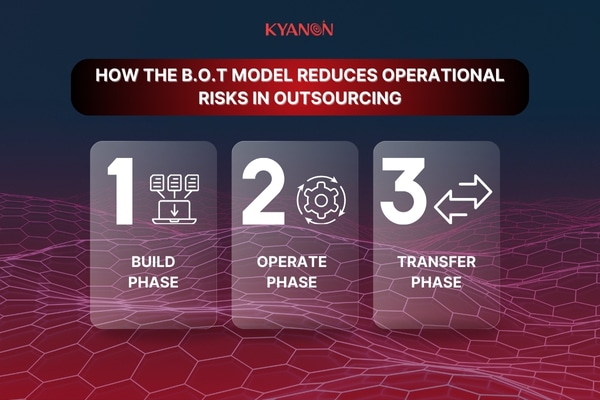
- In the Build phase, the B.O.T. provider handles the setup, ensuring the right technology is in place. This minimizes the risk of choosing outdated or incompatible systems.
- During the Operate phase, the outsourcing team manages day-to-day operations, keeping things running smoothly while your business can focus on growth. Their expertise ensures your project stays on track and avoids costly mistakes.
- Finally, the Transfer phase makes sure your business is fully prepared to take over, with all systems, knowledge, and processes in place. The build operate transfer model allows you to reduce the risks of operational failure, regulatory issues, and technological gaps, ensuring a smooth transition and long-term success for your project.
5. The Build Operate Transfer Model vs. Traditional Outsourcing
Aspect | Traditional Outsourcing | Build Operate Transfer (B.O.T)Model |
Ownership | Limited ownership; The service provider controls most operations. | Full ownership is transferred to the business after the transfer phase. |
Control | Low control over day-to-day activities. | High control during the Build and Operate phases, with full control after transfer. |
Risk | Higher risk due to reliance on the service provider for operations. | Minimized risks with experienced teams managing technology, processes, and compliance. |
Long-Term Sustainability | Dependence on the outsourcing provider for ongoing operations. | Long-term sustainability with full autonomy after the transfer. |
Flexibility | Limited flexibility to adapt or scale operations. | Greater flexibility to scale and adjust as needed during the Build and Operate phases. |
Transition | Harder to transition to internal management; higher costs. | Smooth transition to internal management with complete operational setup in place. |
Cost Control | Can have hidden or ongoing costs over time. | Transparent cost structure with potential savings over time. |
6. Common Challenges of the Build Operate Transfer Model
The build operate transfer model offers numerous benefits, but like any outsourcing strategy, it comes with its own set of challenges.
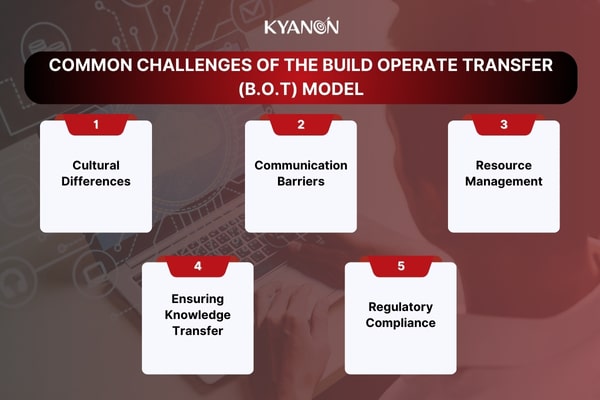
Here’s a look at some common hurdles businesses face when implementing B.O.T and how to tackle them:
6.1. Cultural Differences
- Challenge: Differences in work culture, values, and communication styles can create misunderstandings and inefficiencies.
- Solution: To overcome this, ensure clear communication from the start and invest in cross-cultural training for both in-house and B.O.T teams. Regular meetings and feedback loops can help bridge the gap.
6.2. Communication Barriers
- Challenge: Miscommunication between internal teams and B.O.T. service providers can lead to delays or errors in project execution.
- Solution: Set up regular communication channels like video calls, instant messaging, and project management tools. A dedicated project manager can ensure smooth communication and alignment between both parties.
6.3. Resource Management
- Challenge: Managing resources effectively during the Build and Operate phases can be difficult, especially when scaling up.
- Solution: Plan resource allocation in advance and establish clear roles and responsibilities. Use project management software to track progress and adjust resources as needed to ensure efficiency.
6.4. Ensuring Knowledge Transfer
- Challenge: The success of the final transfer stage depends on how well knowledge is passed from the service provider to the client.
- Solution: Document every process and provide training for your in-house team during the transition. A well-structured knowledge transfer plan ensures that your team is equipped to handle operations independently.
6.5. Regulatory Compliance
- Challenge: Adhering to local laws and regulations, especially in global B.O.T. projects, can be complex.
- Solution: Collaborate with legal experts and ensure that your B.O.T. service provider has a strong understanding of local regulations. Regular audits and checks can help avoid compliance issues.
By addressing these challenges proactively, businesses can maximize the benefits of the build operate transfer model while minimizing potential risks and roadblocks. The right planning and collaboration will ensure smooth implementation and a successful transition.
To Wrap Up
The build operate transfer model offers businesses a clear path to operational independence with minimized risks and greater control.
However, like any outsourcing strategy, it requires careful planning, strong communication, and effective resource management to be successful. By addressing common challenges like cultural differences, communication barriers, and knowledge transfer, businesses can make the most of this powerful model.
Kyanon Digital is your trusted partner for implementing the build operate transfer model. With expertise in managing and delivering high-quality outsourcing solutions, we can help you seamlessly navigate through each phase—Build, Operate, and Transfer. Our team ensures a smooth transition, enabling your business to thrive with full operational control.
Ready to take your business to the next level with the B.O.T. model? Contact Kyanon Digital today for expert consultation and tailored solutions that guarantee long-term success!
